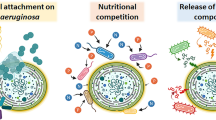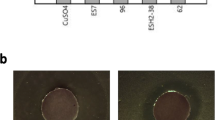Abstract
Unwanted, rapid increases in the algal populations of water systems cause harmful algal blooms, which have recently become a major environmental problem. The cyanobacterium Microcystis aeruginosa is the most prevalent bloom species and is responsible for the majority of blooms in freshwater environments. In this study, we attempted to develop an eco-friendly method to suppress M. aeruginosa bloom based on a biological control using bacteria newly isolated from the soil. In a screen for bacteria with strong lethal activity toward Microcystis, we isolated Bacillus sp. T4 and characterised its algicidal activity. Microcystis aeruginosa cells were killed via indirect attack by compound(s) secreted by T4 bacteria. ELISA revealed a dramatic increase in extracellular microcystins in M. aeruginosa cultures upon treatment with T4. Therefore, we screened for bacteria that could degrade these toxins, and three new isolates (R12, S42 and S65) were identified. Simultaneous application of both T4 as a lytic agent and R12 or S42 as toxin-degrading bacteria could eliminate both Microcystis cells and its problematic toxin. Our eco-friendly approach, based on the application of newly isolated bacteria, provides a novel method to control harmful algal blooms.







Similar content being viewed by others
References
Anderson DM (2009) Approaches to monitoring, control and management of harmful algal blooms (HABs). Ocean Coast Manag 52:342–347
Bourne DG, Riddles P, Jones GJ, Smith W, Blakeley RL (2001) Characterisation of a gene cluster involved in bacterial degradation of the cyanobacterial toxin microcystin LR. Environ Toxicol 16:523–534
Chen X, Xiang H, Hu Y, Zhang Y, Ouyang L, Gao M (2013) Fates of Microcystis aeruginosa cells and associated microcystins in sediment and the effect of coagulation process on them. Toxins 6:152–167
Dittmann E, Wiegand C (2006) Cyanobacterial toxins–occurrence, biosynthesis and impact on human affairs. Mol Nutr Food Res 50:7–17
Dziga D, Wasylewski M, Szetela A, Bocheńska O, Wladyka B (2012) Verification of the role of MlrC in microcystin biodegradation by studies using a heterologously expressed enzyme. Chem Res Toxicol 25:1192–1194
Dziga D, Wasylewski M, Wladyka B, Nybom S, Meriluoto J (2013) Microbial degradation of microcystins. Chem Res Toxicol 26:841–852
Fan J, Hobson P, Ho L, Daly R, Brookes J (2014) The effects of various control and water treatment processes on the membrane integrity and toxin fate of cyanobacteria. J Hazard Mater 264:313–322
Fontanillo M, Köhn M (2017) Microcystins: synthesis and structure–activity relationship studies toward PP1 and PP2A. Bioorg Med Chem. https://doi.org/10.1016/j.bmc.2017.08.040
Gumbo J, Cloete T, van Zyl G, Sommerville J (2014) The viability assessment of Microcystis aeruginosa cells after co-culturing with Bacillus mycoides B16 using flow cytometry. Phys Chem Earth 72:24–33
Gumbo RJ, Ross G, Cloete ET (2008) Biological control of Microcystis dominated harmful algal blooms. Afr J Biotechnol 7:4765–4773
Guo X, Liu X, Pan J, Yang H (2015) Synergistic algicidal effect and mechanism of two diketopiperazines produced by Chryseobacterium sp. strain GLY-1106 on the harmful bloom-forming Microcystis aeruginosa. Sci Rep 5:14720
Ho L, Hoefel D, Saint CP, Newcombe G (2007) Isolation and identification of a novel microcystin-degrading bacterium from a biological sand filter. Water Res 41:4685–4695
Jiang Y, Shao J, Wu X, Xu Y, Li R (2011) Active and silent members in the mlr gene cluster of a microcystin-degrading bacterium isolated from Lake Taihu, China. FEMS Microbiol Lett 322 :108–114
Kenefick S, Hrudey S, Peterson H, Prepas E (1993) Toxin release from Microcystis aeruginosa after chemical treatment. Water Sci Technol 27:433–440
Kim HS, Ahn CY, Joung SH, Ahn JS, Oh HM (2010) Growth inhibition of Microcystis aeruginosa by a glycolipid-type compound from Bacillus subtilis C1. J Microbiol Biotechnol 20:1240–1242
Lee S-O, Kato J, Takiguchi N, Kuroda A, Ikeda T, Mitsutani A, Ohtake H (2000) Involvement of an extracellular protease in algicidal activity of the marine bacterium Pseudoalteromonas sp. strain A28. Appl Environ Microbiol 66:4334–4339
Li H, Ai H, Kang L, Sun X, He Q (2016) Simultaneous Microcystis algicidal and microcystin degrading capability by a single Acinetobacter bacterial strain. Environ Sci Technol 50:11903–11911
Li H, Pan G (2015) Simultaneous removal of harmful algal blooms and microcystins using microorganism-and chitosan-modified local soil. Environ Sci Technol 49:6249–6256
Li Z, Geng M, Yang H (2015) Algicidal activity of Bacillus sp. Lzh-5 and its algicidal compounds against Microcystis aeruginosa. Appl Microbiol Biotechnol 99:981–990
Luo J, Wang Y, Tang S, Liang J, Lin W, Luo L (2013) Isolation and identification of algicidal compound from Streptomyces and algicidal mechanism to Microcystis aeruginosa. PLoS One 8:e76444
Manage PM, Zi K, Nakano S-i (2000) Algicidal effect of the bacterium Alcaligenes denitrificans on Microcystis spp. Aquat Microb Ecol 22:111–117
Paerl HW, Otten TG (2013) Harmful cyanobacterial blooms: causes, consequences, and controls. Microb Ecol 65:995–1010
Park HD, Sasaki Y, Maruyama T, Yanagisawa E, Hiraishi A, Kato K (2001) Degradation of the cyanobacterial hepatotoxin microcystin by a new bacterium isolated from a hypertrophic lake. Environ Toxicol 16:337–343
Paul C, Pohnert G (2011) Interactions of the algicidal bacterium Kordia algicida with diatoms: regulated protease excretion for specific algal lysis. PLoS One 6:e21032
Saito T, Okano K, Park H-D, Itayama T, Inamori Y, Neilan BA, Burns BP, Sugiura N (2003) Detection and sequencing of the microcystin LR-degrading gene, mlrA, from new bacteria isolated from Japanese lakes. FEMS Microbiol Lett 229:271–276
Shimizu K, Maseda H, Okano K, Kurashima T, Kawauchi Y, Xue Q, Utsumi M, Zhang Z, Sugiura N (2012) Enzymatic pathway for biodegrading microcystin LR in Sphingopyxis sp. C-1. J Biosci Bioeng 114:630–634
Shuang L, Xing L, Yanling Y, Rui W Removal of Microcystis aeruginosa and microcystic toxins by four algaecides. In: 2011th international conference on computer distributed control and intelligent environmental monitoring, 2011. The Institute of Electrical and Electronics Engineers, Changsha, Hunan, China, pp 2189–2192
Tamura K, Stecher G, Peterson D, Filipski A, Kumar S (2013) MEGA6: molecular evolutionary genetics analysis version 6.0. Mol Biol Evol 30:2725–2729
Wang H, Liu L, Liu ZP, Qin S (2010) Investigations of the characteristics and mode of action of an algalytic bacterium isolated from Tai Lake. J Appl Phycol 22:473–478
World Health Organisation (1999) Toxic cyanobacteria in water: a guide to their public health consequences, monitoring and management. E&FN Spon, London. pp 95–96
World Health Organisation (2004) Guidelines for drinking-water quality. Vol 2. second edn. World Health Organization, Geneva, Switzerland, pp 940–949
Wu L, Wu H, Chen L, Xie S, Zang H, Borriss R, Gao X (2014) Bacilysin from Bacillus amyloliquefaciens FZB42 has specific bactericidal activity against harmful algal bloom species. Appl Environ Microbiol 80:7512–7520
Xuan H, Dai X, Li J, Zhang X, Yang C, Luo F (2017) A Bacillus sp. strain with antagonistic activity against Fusarium graminearum kills Microcystis aeruginosa selectively. Sci Total Environ 583:214–221
Yang F, Zhou Y, Sun R, Wei H, Li Y, Yin L, Pu Y (2014) Biodegradation of microcystin-LR and-RR by a novel microcystin-degrading bacterium isolated from Lake Taihu. Biodegradation 25:447–457
Yi Y-L, Yu X-B, Zhang C, Wang G-X (2015) Growth inhibition and microcystin degradation effects of Acinetobacter guillouiae A2 on Microcystis aeruginosa. Res Microbiol 166:93–101
Yu J, Kong Y, Gao S, Miao L, Zou P, Xu B, Zeng C, Zhang X (2015) Bacillus amyloliquefaciens T1 as a potential control agent for cyanobacteria. J Appl Phycol 27:1213–1221
Zhang H, Yu Z, Huang Q, Xiao X, Wang X, Zhang F, Wang X, Liu Y, Hu C (2011) Isolation, identification and characterization of phytoplankton-lytic bacterium CH-22 against Microcystis aeruginosa. Limologica 41:70–77
Zhou S, Shao Y, Gao N, Deng Y, Qiao J, Ou H, Deng J (2013) Effects of different algaecides on the photosynthetic capacity, cell integrity and microcystin-LR release of Microcystis aeruginosa. Sci Total Environ 463:111–119
Acknowledgements
This work was supported by the National Research Foundation of Korea (NRF) grant funded by the Korea government (MSIP) (2016R1D1A1B03932773), the World Institute of Kimchi (KE1802-2), funded by the Ministry of Science and ICT and Korea Basic Science Institute under the R&D program (Project No. C38703) supervised by the Ministry of Science and ICT, Republic of Korea. This work was also supported by the research program of KAERI, Republic of Korea. In addition, this research was supported by Korea University Future Research Grant and Korea University (OJERI) Grant.
Author information
Authors and Affiliations
Corresponding authors
Ethics declarations
The authors declare no conflict of interest.
Rights and permissions
About this article
Cite this article
Lee, C., Jeon, M.S., Vo, TT. et al. Establishment of a new strategy against Microcystis bloom using newly isolated lytic and toxin-degrading bacteria. J Appl Phycol 30, 1795–1806 (2018). https://doi.org/10.1007/s10811-018-1403-8
Received:
Revised:
Accepted:
Published:
Issue Date:
DOI: https://doi.org/10.1007/s10811-018-1403-8




